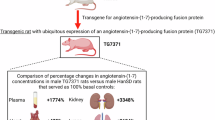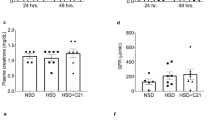Abstract
Angiotensin II (Ang II) promotes sodium-retention, cell growth and fibrosis in addition to its classical effects on blood pressure and fluid homeostasis. In this study we examined whether low and non-hypertensive doses of exogenous Ang II could enhance the intrarenal expression of transforming growth factor-β1 (TGF-β1) observed in rats submitted to sodium overload. Sprague-Dawley-rats were infused for 2 h with 0.1 and 5 μg kg−1 h−1 Ang II (Ang 0.1 and Ang 5, respectively) together with saline solution at four different concentrations (isotonic and Na 0.5 mol L−1, Na 1.0 mol L−1 and Na 1.5 mol L−1). Renal function and mean arterial blood pressure (BP) were measured. The renal distributions of TGF-β1, α-smooth-muscle-actin (α-SMA) and nuclear factor-κB (NF-κB) were evaluated by immunohistochemistry. While the Ang 0.1 groups were normotensive, the Ang 5 groups developed arterial hypertension progressively, and the highest blood pressure values were observed when rats were simultaneously infused with Na 1.5 mol L−1. Glomerular function was not altered in any group. In cortical tubules, all groups infused with Ang II (0.1 and 5) and hypertonic saline solution (HSS) showed an increase in TGF-β1 immunostaining compared to those infused with HSS alone. In medullary tubules, only the Ang 5–Na 0.5 group showed a significant increase in TGF-β 1 immunostaining compared to the Na 0.5 group. Peritubular positive staining for α-SMA was present in groups receiving Ang alone or Ang-Na, in a sodium concentration–dependent manner. In cortical-tubules, NF-κB immunostaining was significantly increased in the Ang groups in comparison with the control and in Ang–Na 0.5 and Ang–Na 1.0 groups in comparison with the Na 0.5 mol L−1 and Na 1.5 mol L−1 groups, respectively, except in the case of the Ang 0.1–Na 1.5 mol L−1 and Ang 5–Na 1.5 mol L−1 groups. Moreover, Ang II and sodium overload induced additional changes in TGF-β1, α-SMA and NF-κB immunostanding in glomeruli, medullary tubules and renal vessels. In conclusion, the interaction of Ang II with acute-sodium overload exacerbated intrarenal TGF-β1, α-SMA and NF-κB expression, independently from changes in blood pressure levels, in normal rats.
Similar content being viewed by others
Article PDF
References
Sanders PW : Effect of salt intake on progression of chronic kidney disease. Curr Opin Nephrol Hypertens 2006; 15: 54–60.
Ruiz-Ortega M, Esteba V, Ruperez M, et al: Renal and vascular hypertension-induced inflammation: role of angiotensin II. Curr Opin Nephrol Hypertens 2006; 15: 159–166.
Kobori H, Ozawa Y, Suzaki Y, Nishiyama A : Enhanced intrarenal angiotensinogen contributes to early renal injury in spontaneously hypertensive rats. J Am Soc Nephrol 2005; 16: 2073–2080.
Wolf G : Role of reactive oxygen species in angiotensin II–mediated renal growth, differentiation, and apoptosis. Antioxid Redox Signal 2005; 7: 1337–1345.
Ruiz-Ortega M, Lorenzo O, Ruperez M, Blanco J, Egido J : Systemic infusion of angiotensin II into normal rats activates nuclear factor-kappaB and AP-1 in the kidney: role of AT(1) and AT(2) receptors. Am J Pathol 2001; 158: 1743–1756.
Wolf G : Renal injury due to renin-angiotensin-aldosterone system activation of the transforming growth factor-β pathway. Kidney Int 2006; 70: 1914–1919.
Naito T, Masaki T, Nikolic-Paterson DJ, Tanji C, Yorioka N, Kohno N : Angiotensin II induces thrombospondin-1 production in human mesangial cells via MAPK and JNK: a mechanism for activation of latent TGF-β1. Am J Physiol Renal Physiol 2004; 286: F278–F287.
Matavelli LC, Matavelli, Varagic J, Susic D, Frolich ED : SALT-loading produces severe renal hemodynamic dysfunction independentof arterial pressure in sponteneously hypertensive rats. Am J Heart Circ Physiol 2006; 292: H814–H819.
Brezniceanu ML, Wei CC, Zhang SL, et al: Transforming growth factor-beta 1 stimulates angiotensinogen gene expression in kidney proximal tubular cells. Kidney Int 2006; 69: 1977–1985.
Roson MI, Cavallero S, Della Penna S, et al: Acute sodium overload produces renal tubulointerstitial inflammation in normal rats. Kidney Int 2006; 70: 1439–1446.
Hsu SM, Raine L, Fanger H : Use of avidin-biotin-peroxidase complex (ABC) immunoperoxidase techniques: a comparison between ABC an unlabeled antibody (PAP) procedures. J Histochem Cytochem 1981; 29: 577–580.
Abe M, O'Connor P, Kaldunski M, Liang M, Roman RJ, Cowley AW : Effect of sodium delivery on superoxide and nitric oxide in the medullary thick ascending limb. Am J Physiol Renal Physiol 2006; 291: F350–F357.
Valles P, Wysocki J, Batlle D : Angiotensin II and renal tubular ion transport. ScientificWorldJournal 2005; 5: 680–690.
Schreck R, Rieber P, Baeuerle PA : Reactive oxygen intermediates as apparently widely used messengers in the activation of NF-κB transcription factor and HIV. EMBO J 1991; 10: 2247–2258.
Dandona P, Kumar V, Aljada A, et al: Angiotensin II receptor blocker valsartan supresses reactive oxygen species geration in leukocytes, nuclear factor-kappa B, in mononuclear cells of normal subjects: evidence of an antiinflammatory action. J Clin Endocrinol Metab 2003; 88: 4496–4501.
Vallon V, Lang F : New insights into the role of serum and glucocorticoid-ducible kinase SGK1 in the regulation of renal function and blood pressure. Curr Opin Nephrol Hypertens 2005; 14: 59–66.
Author information
Authors and Affiliations
Corresponding author
Rights and permissions
About this article
Cite this article
Rosón, M., Cao, G., Della Penna, S. et al. Angiotensin II Increases Intrarenal Transforming Growth Factor-β1 in Rats Submitted to Sodium Overload Independently of Blood Pressure. Hypertens Res 31, 707–715 (2008). https://doi.org/10.1291/hypres.31.707
Received:
Accepted:
Issue date:
DOI: https://doi.org/10.1291/hypres.31.707
Keywords
This article is cited by
-
Clues and new evidences in arterial hypertension: unmasking the role of the chloride anion
Pflügers Archiv - European Journal of Physiology (2022)



